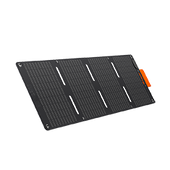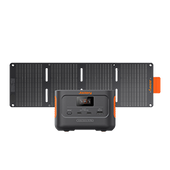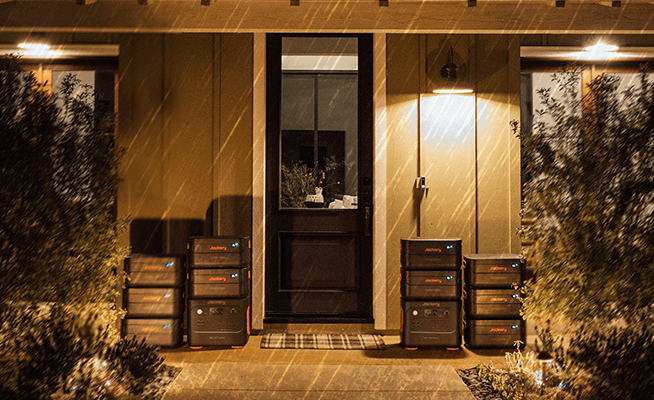A solar farm is a piece of land dedicated to the large-scale production of green energy through solar panels. The popularity of solar farms has exploded in recent years, echoing the rise of home solar panel systems.
Solar farms provide green, renewable and local electricity to millions of homes and businesses, create jobs, support communities and enhance biodiversity. As technology improves and costs decrease, the UK is also paying increasing attention to the construction and development of solar farms.
If you think solar farms will cost too much, consider having a solar generator, like Jackery Solar Generator, which is also a wise investment to charge appliances with solar energy.
|
Key Takeaways: |
|
- Solar farms produce electricity on a large scale and distribute it to homes and businesses. - There are various types of solar farms in the UK that can meet different scenarios and needs. At present, many solar farms provide the UK with a large amount of clean energy. - Rationally speaking, building solar farms in the UK may be difficult and expensive. - Whether building large-scale solar farms in the UK is worthwhile requires a comprehensive assessment. - If you think solar farms are unsuitable but still want to try solar energy, consider a solar generator, like Jackery Solar Generator 1000 Plus or 2000 Plus. - Although there are some challenges to overcome, the future of solar farms in the UK is bright. |
What Is a Solar Farm?
A solar farm is a large solar photovoltaic (PV) system that supplies commercial electricity to the grid. It is much larger than a residential farm and can cover several acres. A solar farm can also be called a solar field, solar park, photovoltaic power station, large-scale solar (LSS) or solar power plant.
Solar farms have many benefits for the UK's environment and economy. The rising cost of arable land and livestock farming has prompted some farmers to rent their land to energy companies to install solar panels or proactively install their renewable energy generation systems to take advantage of the green revolution. In simple terms, a solar farm is a larger version of the solar power systems you see on homes across the UK.
How Does a Solar Farm Work?
A solar farm works by converting sunlight into electricity using solar panels. Unlike rooftop panels that power a single home or unit, a solar farm produces electricity on a large scale and feeds it into the grid, which is then distributed to homes and businesses.
Energy Collection
Solar panels receive sunlight and produce direct current electricity through the photovoltaic effect. These panels are often combined into large arrays to increase their electricity generation. The number and type of solar panels used in a solar farm depend on its size and location.
Power Conversion
The inverter converts electrical energy into a current compatible with the grid, meeting the grid's and users' needs. It can also automatically stabilise the voltage and improve the quality of the power supply.
Power Transmission and Storage
The converted AC power is integrated into the local grid for home and industrial use. Excess electricity is stored in batteries for future use. The following figure is a schematic diagram of the working principle of a solar farm:

Types of Solar Farms in the UK
Solar farms have the potential to boost local economies by reducing emissions, providing renewable energy, and reducing the impact of climate change. Various solar farm types in the UK can meet different scenarios and needs. Solar farms in the UK can be mainly divided into the following types:
Ground-mounted Solar Farms: Ground-mounted solar farms are the most common type and are usually built on large open spaces or farmland. Their advantages are their large scale, high power generation efficiency, and relatively low construction costs. For example, Blackthorpe Solar Farm in Norfolk (one of the largest solar power plants in the UK) is a typical ground-mounted solar farm.
Rooftop Solar Farms: Rooftop solar farms are mainly built on the roofs of residential, commercial, or industrial buildings. Although the power generation of a single rooftop solar system is relatively small, it can be deployed on a large scale and can provide considerable power overall. For example, many large shopping malls and public buildings in London have installed rooftop solar panels.
Water-mounted Solar Farms: Water-mounted solar farms are emerging solar farms that install solar panels on the surface of reservoirs, lakes, or ponds. Floating solar farms have the advantage of using idle water resources, and the cooling effect of water can also improve the efficiency of solar panels.
Agricultural Solar Farms: Agricultural solar farms combine solar power generation with agrarian planting. Planting crops under solar panels can generate electricity and carry out agricultural production, achieving efficient land use. For example, some farms in the UK have begun to try to grow vegetables under solar panels.
Community Solar Farms: Community solar farms are community-based solar power generation projects, which are usually jointly invested in and owned by community residents. The advantage of community solar farms is that they can promote community participation, improve energy self-sufficiency, and provide economic benefits to community residents.
For example, the Central Community Energy of England (HECE) project near Stratford-upon-Avon can generate 14.7 megawatts of energy and power thousands of households.
5 Examples of Solar Farms in the UK
The UK has made significant progress in the field of solar power generation. Solar power accounts for 2-10% of the UK's electricity supply. The construction and operation of solar farms provide the UK with a lot of clean energy and contribute to reducing carbon emissions. Here are five examples of UK solar farms:

1. Shotwick Solar Farm
Location: A548, Deeside CH64 5SP UK
Year founded: 2016
Size (Acres): 250
Size (MW): 72.2
Shotwick Solar Farm produces enough electricity each year to power 18,055 average homes.
However, Shotwick Solar Farm is unique in that it is not connected to the national grid. Instead, it is connected to the nearby UPM Shotton paper mill via a dedicated line, meeting 70% of the mill's energy needs while saving on transmission and distribution costs.
2. West Raynham Solar Farm
Location: Fakenham NR21 7PL UK
Year founded: 2015
Size (Acres): 225
Size (MW): 49.8
West Raynham Solar Farm was built on a former Royal Air Force base decommissioned in 1994. It produces 48,153 MWh of electricity annually, enough to power 14,000 homes. As a result, it offsets 21,460 tonnes of CO2 emissions per year. West Raynham Solar Farm is connected to the national grid and sells electricity to various energy suppliers under long-term contracts.
3. Llanwern Solar Farm
Location: Newport, Gwent Levels, Wales, United Kingdom
Year founded: 2021
Size (Acres): 260
Size (MW): 49.9
Llanwern Solar Farm, the UK's largest solar farm, is between Newport and the Bristol Channel in southeast Wales. The massive project is spread over three sites and cost £43 million.
4. Larks Green Solar Farm
Location: Lower Farm, Itchington BS35 3TH United Kingdom
Year founded: 2023
Size (Acres): 106
Size (MW): 49.9
Until now, It has fed its electricity exclusively to its regional distribution network operator (DNO). Like Shotwick Solar Farm, Larks Green Solar Farm can only supply 49.9MW to the grid using AC power, although its DC output is higher.
5. The Grange Solar Farm
Location: Nottinghamshire, East Midlands, England, United Kingdom
Year founded: 2021
Size (Acres): 207
Size (MW): 49.9
The Grange Solar Farm was initially (2011) a 5MW solar farm, which was expanded in 2016 to develop a larger 49.9MW solar farm, completed in 2020. The farm was sold to NextEnergy in 2020. The Grange Solar Farm also has a 15-year power purchase agreement with Anheuser-Busch InBev, the world's largest brewer, to purchase approximately 75% of its electricity.
How to Build a Solar Farm in the UK?
Building a solar farm in the UK can provide a stable power supply to the local area. However, starting a solar farm in the UK needs a comprehensive understanding of local laws and regulations. Here are a few steps to build a solar farm in the UK:

Step 1: Project Planning and Preparation
In the UK, project planning and related preparations are required before building a solar farm.
Resource Assessment: Please assess the solar resources at the project site, including measuring the duration of sunshine, radiation intensity and climate conditions in the area.
|
Average Annual Sunshine in the UK |
||
|
Region |
Place |
Hours |
|
Southern England |
Birmingham |
1501 |
|
Bristol |
1485 |
|
|
Dover |
1770 |
|
|
Isles of Scilly |
1708 |
|
|
London, Greenwich |
1526 |
|
|
London, Kew Gardens |
1693 |
|
|
Norwich |
1611 |
|
|
Nottingham |
1487 |
|
|
Plymouth |
1732 |
|
|
Southampton |
1706 |
|
|
Stoke-on-Trent |
1485 |
|
|
Weymouth |
1904 |
|
|
Northern England |
Ambleside, Windermere Lake |
1225 |
|
Berwick-upon-Tweed |
1535 |
|
|
Dumfries |
1309 |
|
|
Hull |
1559 |
|
|
Manchester |
1385 |
|
|
Middlesbrough |
1395 |
|
|
Newcastle upon Tyne |
1337 |
|
|
Prestwick |
1401 |
|
|
Sheffield |
1485 |
|
|
Wales |
Cardiff |
1573 |
|
Llandrindod Wells |
1279 |
|
|
Scotland |
Aberdeen |
1447 |
|
Dundee |
1461 |
|
|
Edinburgh |
1449 |
|
|
Glasgow |
1280 |
|
|
Inverness |
1250 |
|
|
Kirkwall, Orkney Islands |
1210 |
|
|
Lerwick, Shetland Islands |
1158 |
|
|
Stornoway, Outer Hebrides |
1256 |
|
|
Tiree, Inner Hebrides |
1524 |
|
|
Northern Ireland |
Armagh |
1279 |
|
Belfast |
1277 |
|
|
Londonderry |
1359 |
|
(Data Source: current results )
Feasibility Study: Conduct a comprehensive feasibility study, including geological conditions, environmental impacts, transportation convenience, grid access points, and the degree of support for solar power generation projects by local policies and regulations.
Financing: Government subsidies, bank loans, and private investment can raise the large initial investment in solar farms. The UK government provides various financial support and incentives for renewable energy projects.
Step 2: Land Site Selection and Design
Select a flat, open, sunny site and avoid areas with many shadows, unstable soil, or high flood risk. The preliminary layout of the solar farm will also be designed according to the site's specific conditions.
Step 3: Permits and Approvals
Apply to the local government to build a solar farm, including an environmental impact assessment report, a project plan, etc. According to UK planning regulations, planning and ecological permission may be required.
- You should apply for planning permission from your local council or government department.
- You must reach a connection and distribution agreement with the local grid operator.
Step 4: Construction and Installation
Build the solar farm's infrastructure according to the design plan, including foundation works, roads, fences, etc. Purchase solar power generation equipment that meets the United Kingdom's national standards and specifications. Please conduct tests (including electrical performance and safety tests) after construction to ensure that all systems operate typically.
Jackery Solar Generators Explained
A solar generator is preferred over a solar farm when portable, on-demand power is required on a smaller scale, for camping, emergencies, or a limited number of devices in a remote location.
In contrast, a solar farm is intended to generate large-scale electricity for a grid. It requires a fixed location and significant land space to be effective, rendering it unsuitable for portability or immediate power needs.
Solar generators are intended for portability and can be employed anywhere that receives sunlight, whereas solar farms are substantial, permanent installations. Solar generators are adequate for smaller power requirements even though solar farms generate substantially more power due to their larger panel array.
Solar generators are ideally suited for personal use when grid power is unavailable, such as during power disruptions or camping. Conversely, solar farms are designed to provide electricity to a larger community. Here, we introduce Jackery Solar Generator, which combines Jackery Solar Panels with a Portable Power Station to use solar energy effectively.

Jackery Solar Generator 2000 Plus
Jackery Solar Generator 2000 Plus is the most suitable home or business generator. It is a solid portable power solution that delivers outstanding performance. With its impressive capacity and powerful output, this device can support the operation of essential appliances for weeks, even certain large appliances, such as your refrigerator, computer, portable AC, etc., in your home or company.
- Expandable Powerhouse for Your Appliances: The Jackery Solar Generator 2000 Plus enables the addition of extra battery packs, increasing the capacity from 2 kWhto an impressive 12 kWh, thereby significantly satisfying your power needs. This solar product has a remarkable output of 3000W, providing a 30% higher rated power than other 2 kWh solar products.
- Safe to Use with ChargeShield: ChargeShield is Jackery's advanced fast charge technology, featuring 62protective mechanisms, 12 protective algorithms, and four types of physical safety protection. This technology uses a unique stepped variable-speed charging algorithm to enhance safety and extend battery pack lifespan by 50%.
- Higher Resistance & Reliability: The Explorer 2000 Plus stands out as a groundbreaking add-on battery pack that offers the convenience of recharging through solar panels. This feature increases versatility, boosts charging efficiency, and shortens charging time.
|
*Review from Our User |
|
I have been using Jackery batteries for a long time. I felt great excitement upon the release of the Explorer 2000 Plus, which marks the inaugural release of an expendable battery system by Jackery. The system supports a capacity of up to 12kWh with a 3000W 120V output or 24kWh with a 6000W 240V output—an ideal enhancement for my home backup system. |

Jackery Solar Generator 1000 Plus
Jackery Solar Generator 1000 Plus combines SolarSaga 100W solar panels with Explorer 1000 Plus. The Explorer 1000 Plus is the same as the Explorer 2000 Plus, which is the expandable LiFePO4 battery to be added to a 5 kWh capacity. If Jackery Solar Generator 2000 Plus is for charging your appliances for a few weeks, this solar generator is for charging for several days.
- Excellent Power Output: The Explorer 1000 Plus power station boasts an excellent 1264Wh long-lasting LiFePO4 battery and a 2000W full-power pure sine wave inverter, supplying almost all required power. Adding up to three additional battery packs will remarkably increase its capacity to 5kWh.
- Expandable Powerhouse: Adding up to three extra battery packs lets Jackery's exclusive technology boost the Explorer 1000 Plus capacity from 26kWh to5kWh. Moreover, it has a maximum output of 2000W, 20% more than usual 1kWh LFP generators.
- Higher Solar Conversion Rate: The Jackery SolarSaga 100W Solar Panel boasts a solar conversion rate of up to 25%; it is optimally designed for outdoor use and unforeseen power interruptions. The solar panel weighs about 8 lbs, is lightweight, foldable, and equipped with a convenient carry handle, enhancing its portability.
|
*Review from Our User |
|
First, this item is robust and space-efficient, fitting seamlessly in my workspace (see pic). When the power goes out, it becomes a real game changer. I can continue my tasks as if everything is normal, which is impressive. The most advantageous aspect for me? The USB-C ports. I can connect my Mac directly to it without needing an adapter. Incredibly useful! |

Are Solar Farms Worth It in the UK?
Is it worthwhile to build a solar farm in the UK? Generally, whether it is worthwhile to build solar farms on a large scale in the UK requires a comprehensive assessment from multiple aspects.
Feasibility of Building Solar Farms in the UK
Building solar farms in the UK helps protect the environment, brings economic benefits and is supported by government policies.
Environmental Benefits
Solar power generation can reduce carbon dioxide emissions by about 0.9 kg for every kilowatt-hour of electricity produced. In addition, the construction of solar farms will help the UK reduce carbon emissions.
Economic Feasibility
According to the British Solar Trade Association, the cost of solar power generation has fallen by about 80% in the past decade. In addition, the construction of solar farms will drive the development of the local economy and create jobs. Solar farms will also provide a stable electricity supply to the local area during operation and reduce electricity costs.
Policy Support
The British government has provided a series of policies and financial support, such as feed-in tariffs, to encourage renewable energy development.
Challenges of Building Solar Farms in the UK
Although there are many benefits to building solar farms in the UK, there are also some challenges.
Geographical and Climatic Conditions
The weather in the UK is changeable, and cloudy and rainy weather is more common, affecting solar panels' power generation efficiency. Although technological advances have enabled solar panels to work under low-light conditions, power generation will still be affected to a certain extent.
Land Utilisation
Solar farms require a lot of land to install solar panels, which may be a problem in the UK, where land resources are relatively tight. Increasing land utilisation by installing solar panels on roofs, agricultural land, etc., will also increase the complexity and cost of the project.
The following is an analysis of the advantages and disadvantages of building a solar farm in the UK for your reference:
|
Advantages and Disadvantages of Building a Solar Farm in the UK |
|
|
Advantages |
Disadvantages |
|
Clean and renewable energy Land use Easy maintenance Local energy production Reduces dependence on scarce fossil fuels |
Occupies a lot of land Highly affected by weather Poor aesthetics High initial investment |
In summary, building solar farms in the UK has many benefits but also faces many challenges. Therefore, whether it is worthwhile to build solar farms on a large scale in the UK requires detailed evaluation and planning based on specific circumstances.
The Future of Solar Farms in the UK
In recent years, the UK's solar industry has been developing strongly. The UK government has actively promoted the development of renewable energy. The UK solar market is expected to reach 18.53 GW in 2024 and increase to 53.12 GW by the end of 2029. Some forecasts suggest that in 2030, solar energy could account for 20% of the UK's electricity generation.
Technological innovation also provides a strong impetus for the future development of solar farms in the UK. The UK is currently exploring innovative technologies such as windows that capture sunlight and convert it into solar energy and space-based solar power generation.
In addition, the future development of solar farms in the UK also faces some challenges, such as the construction and operation of solar farms requiring a lot of financial support. Many in the UK also worry that solar farms will affect the landscape and biodiversity.
In short, although there are some challenges to overcome, the future of solar farms in the UK is bright, driven by government support, public demand, technological progress, and the need for sustainable and renewable energy.
Solar Farms in The UK FAQs
The following are the frequently asked questions about the solar farms in the UK:
- Do solar farms work in the UK?
A solar farm is a large-scale application of solar photovoltaic (PV) systems that can provide secure, locally produced renewable electricity for many years after it is built. In addition, based on the average annual household electricity consumption, a solar farm can power about 1,500 homes a year for every 5 MW installed. In short, the UK needs to increase its reliance on solar farms to achieve the EU's 2030 target of at least 42.5% renewable energy.
- How much does a 1-acre solar farm cost in the UK?
The cost of a solar farm per acre in the UK usually includes the following:
- Land cost (the average cost between £7,500 and £10,000 / an acre of rural land)
- Equipment and installation costs (solar equipment costs about £800 to £1,200 per kilowatt-hour (kWh)).
- Construction and other costs (project management costs usually account for 5% to 10% of the total cost.)
- Operation and maintenance costs (usually account for 10% to 15% of the total project cost)
Assume a solar farm covers an area of 2 acres and has an installed capacity of 1MW.
|
The Cost of a Solar Farm |
|
|
Land Cost |
£15,000 to £20,000 |
|
Equipment & Installation Cost |
£800,000 to £1.2 million |
|
Project Management Costs |
£50,000 to £160,000 |
|
Operation & Maintenance Costs |
£100,000 to £240,000 |
|
Cost Per Acre is £482,500 to £810,000 |
|
However, in the UK, the cost per acre of solar farms will vary depending on project size, location, and equipment choice.
- Do you need permission to builda solar farm?
In the UK, approval for a solar farm must undergo a series of rigorous planning procedures, taking into account the suitability of the site, the potential impact on the local area (whether the presence of the solar farm will damage or endanger the environment, taking into account ecological and socio-economic factors), and relevant renewable energy targets.
Final Thoughts
In this article, we explore the basics of solar farms, their types, and the advantages and challenges of developing them in the UK. While the early steps and setup of starting a solar farm can be challenging, the investment is worth it in many ways. Thousands of solar farms have improved the UK's power generation and energy markets to a certain extent, contributing to a greener and more sustainable future.






























































































